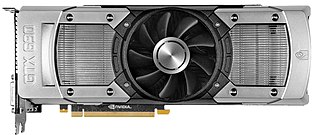Related Research Articles

Microsoft DirectX is a collection of application programming interfaces (APIs) for handling tasks related to multimedia, especially game programming and video, on Microsoft platforms. Originally, the names of these APIs all began with "Direct", such as Direct3D, DirectDraw, DirectMusic, DirectPlay, DirectSound, and so forth. The name DirectX was coined as a shorthand term for all of these APIs and soon became the name of the collection. When Microsoft later set out to develop a gaming console, the X was used as the basis of the name Xbox to indicate that the console was based on DirectX technology. The X initial has been carried forward in the naming of APIs designed for the Xbox such as XInput and the Cross-platform Audio Creation Tool (XACT), while the DirectX pattern has been continued for Windows APIs such as Direct2D and DirectWrite.

OpenGL is a cross-language, cross-platform application programming interface (API) for rendering 2D and 3D vector graphics. The API is typically used to interact with a graphics processing unit (GPU), to achieve hardware-accelerated rendering.
Direct3D is a graphics application programming interface (API) for Microsoft Windows. Part of DirectX, Direct3D is used to render three-dimensional graphics in applications where performance is important, such as games. Direct3D uses hardware acceleration if it is available on the graphics card, allowing for hardware acceleration of the entire 3D rendering pipeline or even only partial acceleration. Direct3D exposes the advanced graphics capabilities of 3D graphics hardware, including Z-buffering, W-buffering, stencil buffering, spatial anti-aliasing, alpha blending, color blending, mipmapping, texture blending, clipping, culling, atmospheric effects, perspective-correct texture mapping, programmable HLSL shaders and effects. Integration with other DirectX technologies enables Direct3D to deliver such features as video mapping, hardware 3D rendering in 2D overlay planes, and even sprites, providing the use of 2D and 3D graphics in interactive media ties.

A graphics processing unit (GPU) is a specialized electronic circuit designed to rapidly manipulate and alter memory to accelerate the creation of images in a frame buffer intended for output to a display device. GPUs are used in embedded systems, mobile phones, personal computers, workstations, and game consoles.
General-purpose computing on graphics processing units is the use of a graphics processing unit (GPU), which typically handles computation only for computer graphics, to perform computation in applications traditionally handled by the central processing unit (CPU). The use of multiple video cards in one computer, or large numbers of graphics chips, further parallelizes the already parallel nature of graphics processing.

Quadro was Nvidia's brand for graphics cards intended for use in workstations running professional computer-aided design (CAD), computer-generated imagery (CGI), digital content creation (DCC) applications, scientific calculations and machine learning.
The Brook programming language and its implementation BrookGPU were early and influential attempts to enable general-purpose computing on graphics processing units. Brook, developed at Stanford University graphics group, was a compiler and runtime implementation of a stream programming language targeting modern, highly parallel GPUs such as those found on ATI or Nvidia graphics cards.

CUDA is a parallel computing platform and application programming interface (API) that allows software to use certain types of graphics processing unit (GPU) for general purpose processing – an approach called general-purpose computing on GPUs (GPGPU). CUDA is a software layer that gives direct access to the GPU's virtual instruction set and parallel computational elements, for the execution of compute kernels.

nouveau is a free and open-source graphics device driver for Nvidia video cards and the Tegra family of SoCs written by independent software engineers, with minor help from Nvidia employees.
In computing, Close To Metal is the name of a beta version of a low-level programming interface developed by ATI, now the AMD Graphics Product Group, aimed at enabling GPGPU computing. CTM was short-lived, and the first production version of AMD's GPGPU technology is now called AMD Stream SDK, or rather the current AMD APP SDK for Windows and Linux 32-bit and 64-bit. APP stands for "Accelerated Parallel Processing" and also targets Heterogeneous System Architecture.

In the field of 3D computer graphics, the unified shader model refers to a form of shader hardware in a graphical processing unit (GPU) where all of the shader stages in the rendering pipeline have the same capabilities. They can all read textures and buffers, and they use instruction sets that are almost identical.
AMD FireStream was AMD's brand name for their Radeon-based product line targeting stream processing and/or GPGPU in supercomputers. Originally developed by ATI Technologies around the Radeon X1900 XTX in 2006, the product line was previously branded as both ATI FireSTREAM and AMD Stream Processor. The AMD FireStream can also be used as a floating-point co-processor for offloading CPU calculations, which is part of the Torrenza initiative. The FireStream line has been discontinued since 2012, when GPGPU workloads were entirely folded into the AMD FirePro line.

OpenCL is a framework for writing programs that execute across heterogeneous platforms consisting of central processing units (CPUs), graphics processing units (GPUs), digital signal processors (DSPs), field-programmable gate arrays (FPGAs) and other processors or hardware accelerators. OpenCL specifies programming languages for programming these devices and application programming interfaces (APIs) to control the platform and execute programs on the compute devices. OpenCL provides a standard interface for parallel computing using task- and data-based parallelism.
Nvidia Ion was a product line of Nvidia Corporation intended for motherboards of low-cost portable computers. It used graphics processing units and chipsets intended for small products.
Serving as the introduction of Fermi, the GeForce 400 series is a series of graphics processing units developed by Nvidia. Its release was originally slated in November 2009; however, after delays, it was released on March 26, 2010 with availability following in April 2010.

Serving as the introduction of Kepler architecture, the GeForce 600 series is a series of graphics processing units developed by Nvidia, first released in 2012.

The GeForce 700 series is a series of graphics processing units developed by Nvidia. While mainly a refresh of the Kepler microarchitecture, some cards use Fermi (GF) and later cards use Maxwell (GM). GeForce 700 series cards were first released in 2013, starting with the release of the GeForce GTX Titan on February 19, 2013, followed by the GeForce GTX 780 on May 23, 2013. The first mobile GeForce 700 series chips were released in April 2013.
In computing, a compute kernel is a routine compiled for high throughput accelerators, separate from but used by a main program. They are sometimes called compute shaders, sharing execution units with vertex shaders and pixel shaders on GPUs, but are not limited to execution on one class of device, or graphics APIs.
Nvidia GeForce RTX is a high-end professional visual computing platform created by Nvidia, primarily used for designing complex large scale models in architecture and product design, scientific visualization, energy exploration, and film and video production. Nvidia RTX enables realtime ray tracing. Historically, ray tracing had been reserved to non-real time applications, with video games having to rely on direct lighting and precalculated indirect contribution for their rendering. RTX facilitates a new development in computer graphics of generating interactive images that react to lighting, shadows and reflections. RTX runs on Nvidia Volta-, Turing- and Ampere-based GPUs, specifically utilizing the Tensor cores on the architectures for ray-tracing acceleration.
References
- ↑ "DirectCompute". developer.nvidia.com. NVIDIA. 28 September 2010. Retrieved 22 March 2015.